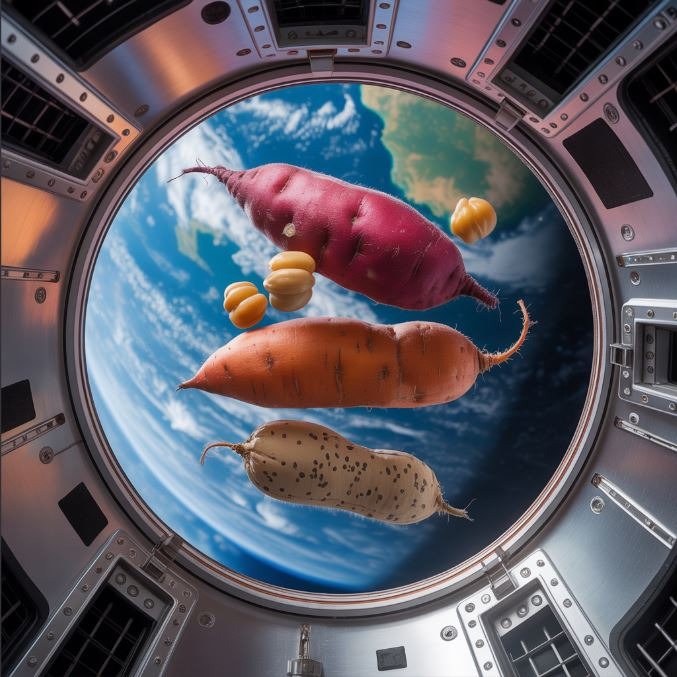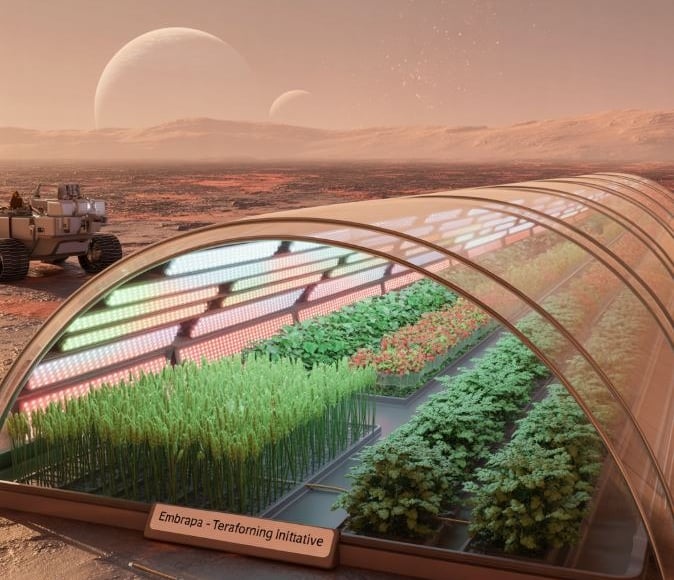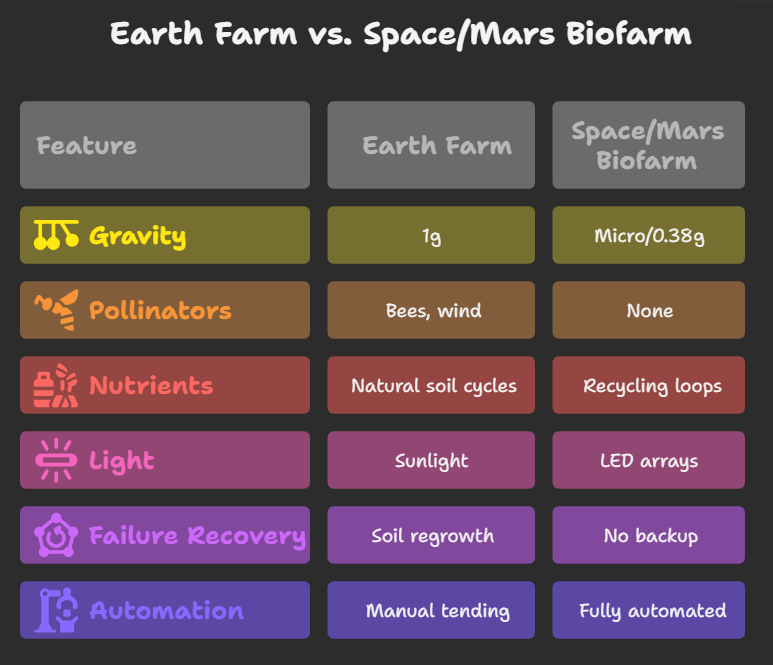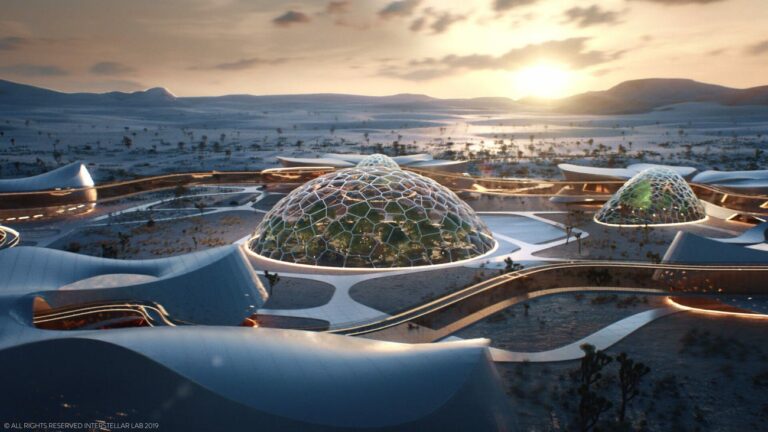Mission NS-31: Blue Origin and Embrapa’s Space Bioengineering Mission
Brazilian Embrapa seeds traveled to space on a historic Blue Origin mission, aiming to advance agriculture in extreme environments.


Space Bioengineering and Closed‑Loop Life Support Systems: From Growing Plants in Microgravity to Lunar Colonies
Space exploration and astrobiology provoke fascinating questions: can agriculture transcend Earth? In long‑duration missions—to the Moon, Mars, or orbital colonies—growing plants isn’t a luxury, it’s a necessity. Plants supply fresh food rich in essential nutrients (like vitamin C and antioxidants), vital for preventing deficiencies on journeys lasting months or years. Additionally, keeping a garden in space improves astronauts’ psychological well‑being and helps recycle carbon dioxide into oxygen in a closed environment.
The collaborative effort between agencies and research institutes such as Embrapa and the Brazilian Space Agency (AEB) positions Brazil at the forefront of Space Agriculture, aligned with Artemis Accords for lunar and Martian cooperation. The goals are twofold: ensure local food production and develop bioregenerative life support systems (BLSS) that integrate bioengineering, automation, and artificial intelligence. In other words: create fully automated closed-space “bio‑reactor farms” capable of recycling water, nutrients, and air without constant human intervention.
Brazilian scientists have formed the Space Farming Brazil Network (Embrapa + AEB) to innovate these extraterrestrial systems. This interdisciplinary approach even inspires terrestrial agricultural innovation—much like how Apollo-era spaceflight spurred technological advances on Earth.
1. Fundamentals of Space Bioengineering
Space bioengineering merges biology and engineering to adapt plants to the rigors of microgravity. This includes: selecting stress-hard cultivars, maintaining growth environments 24/7, and closing nutrient and water cycles. In prior demonstration missions, model crops like lettuce, eggplant, wheat, and Arabidopsis have successfully germinated, grown, flowered, and even fruited in microgravity conditions.
For example, NASA’s Veggie system aboard the ISS enabled astronauts to grow and consume lettuce, Chinese cabbage, radish, tomato, and even zinnia flowers using clay-based “plant pillows” and moisture-control gels. In microgravity—where roots and stems lose their gravitational orientation—targeted red/blue LEDs guide growth direction, and specialized pillows distribute water without forming air bubbles.
Target species: Fast-growing, nutrient-dense crops. Brazil has selected sweet potato and chickpea as model crops due to their stress tolerance and high nutritional value—including low–glycemic index carbohydrates and protein. These species have extensive germplasm banks in Brazil, facilitating selection of robust varieties.
Substrates and systems: Since lunar and Martian soils are sterile, crops are grown in water via hydroponics or nutrient-rich mist via aeroponics. Brazilian research explores nitrogen-fixing microbial fertilizers to enrich these closed systems.
LED lighting: Specialized LED arrays (blue/red spectrum, reduced green) maximize photosynthetic efficiency under low power—this technology has boosted Earth-based vertical farming, as advanced LEDs and sensors developed for ISS applications have migrated to agritech solutions on Earth.
Sensors and automation: Closed space systems demand real-time monitoring—measuring CO₂, humidity, nutrient levels, temperature, and even plant bioelectric signals. AI tools can detect early stress and adjust environmental parameters automatically (CO₂ levels, irrigation, lighting). Prototype plant‑computer interfaces can interpret electrical fluctuations akin to a plant’s ECG, diagnosing thirst or nutrient deficiency remotely.
Reproduction and genetics: Seeds destined for space are selected or irradiated to withstand cosmic radiation. Mutagenesis using gamma or neutron radiation creates genetic variability for early-ripening and stress-tolerant lines. Genetic editing (CRISPR) is emerging as a tool to activate stress‑tolerance genes—though much effort continues in physical and environmental cultivation solutions.
Previous space agriculture experiments include:
1980s–2000s: NASA, USSR/Russian, and Japanese programs conducted basic plant growth tests in Skylab, Mir, and early orbital labs.
ISS era (2014–2020): The ISS’s Veggie system cultivated lettuce, mizuna, and zinnia flowers; the Automated Plant Habitat (APH) enabled longer-term studies. China’s Tiangong station also grew leafy greens.
2023–2025: Brazil enters the scene: in April 2025, Blue Origin’s suborbital NS‑31 mission carried Brazilian sweet potato (Covington and Beauregard) and chickpea (BRS Aleppo) seeds for microgravity experiments. Data from this and future flights will serve as biological foundations for fully automated Brazilian space biofactories.
These experiments prove cultivation beyond Earth is feasible, though the technical focus now is optimizing every life‑cycle stage—from germination to harvest—integrating genetic knowledge, biotech, automation, and recycling. Each breakthrough—efficient LEDs, engineered microbes, or robust cultivars—benefits spacefarers and terrestrial farmers alike.
2. Challenges and Solutions in Closed-Loop Life Support Systems
Space farms function as completely sealed ecosystems—astronauts exhale CO₂, plants convert it into O₂. There are no windows or natural rain, so full resource recycling and full automation are critical.
Key technical challenges and engineered solutions:
Zero gravity and orientation: Without gravity, roots lack direction. LED positioning guides roots and stems phototropically. The Veggie system uses red/blue lighting to coax plants to orient “upward” or “downward” in place of gravity.
Gas mixing: In microgravity, CO₂ doesn’t convect and accumulates around plants while oxygen rises—risking plant suffocation. Active ventilation mixes air in cultivation modules to ensure balanced gas distribution.
Limited water and nutrients: Water is precious, and there’s no rainfall. Hydro- and aeroponic systems deliver nutrient solutions or mist. Water is filtered and reused with minimal loss. Nutrients are carefully balanced (synthetic fertilizers or engineered microbes), monitored by sensors in real time. Brazilian teams work on nitrogen-fixing microbial systems that enhance nutrient uptake in soil-free environments.
Cosmic radiation: Outside Earth’s atmosphere, plant DNA and proteins are vulnerable to ionizing radiation. Physical shields (water or polymer barriers) and tolerant cultivars help mitigate damage. Brazilian researchers plan to irradiate seeds pre-launch to induce beneficial mutagenesis. Studies show plants exposed to microgravity activate stress-related genes, potentially improving resilience.
Automated maintenance and AI: Astronaut‑farmers cannot tend crops continuously. Robotic systems handle planting, harvesting, and reseeding autonomously. AI interprets sensor data to adjust light, water and nutrient levels—“throttling” growth when needed and optimizing yields. Computer vision and machine learning can detect early leaf disease or deficiencies before they become visible.
3. Toward Lunar and Martian Colonies
Why is all this so vital? Every kilogram of food lifted into orbit costs thousands of dollars. Colonists on the Moon or Mars must grow their own nutrition locally. Biofarms must be efficient, resilient—and interplanetary‑proven.
Brazil, via EMBRAPA and its collaboration with global space agencies, is emerging as a vital contributor in this field. Seed data gathered from ISS and suborbital flights feed into cultivation algorithms, infrastructure designs, and automated greenhouses that may one day sustain the first Martians.
For the geek community and future scientists: space bioengineering is more than futuristic fantasy—it demands mastery at the intersection of biology, systems engineering, AI, and materials science. It's about designing and growing life beyond Earth.
Final Thoughts: The Future Is Grown, Not Just Launched
Rockets are only step one in humanity's mission to live off the planet. Truly surviving requires sustainable systems—and that journey begins underground, in LED-lit growth chambers controlled by AI algorithms.
Brazil’s leadership via EMBRAPA and global partnerships is turning seed data into actionable technology—biofactories that might nourish lunar or Martian pioneers. The lessons learned will also transform Earth's agriculture, creating innovations in vertical farms, precision microbe-enhanced crops, and renewable-resource systems.
For the next generation of nerds: your challenge awaits. Can you code the future of farming? Build ecosystems that self‑heal? Help humanity thrive beyond Earth?
Life sciences are orbiting overhead—dare to grow them.
To delve deeper into the topic, here are links for more information:
"Growing Plants in Space" by NASA -
"Details the launch of BRS Aleppo chickpea seeds aboard Blue Origin’s NS-31 mission and partnerships with Brazilian and U.S. institutions to foster space farming research and education": https://www.seedworld.com/latam/2025/06/17/chickpea-seeds-launched-in-rocket-through-partnership-with-space-farming-brazil-network/
Interstellarlab - "develop intelligent biospheric systems to grow life autonomously on Earth and in Space"
"Embrapa begins research on sweet potato and chickpea cultivation in space"








